Cape Cod Creature {Updated Video – Dolphin Stranding?}
Posted by: Loren Coleman on June 4th, 2012
This is a breaking story. Is it an unknown or known species? Is it a well-place gaffe, a construction, a hoax? A closer examination is required. Can you help?
An informant has written and forwarded the following photographs, in hopes of identifying what he reportedly saw this week on Cape Cod.
This was allegedly viewed on a beach on Cape Cod on Thursday morning, May 31, 2012. It appeared to the witness to be “a very strange, large, eel like, prehistoric looking thing…the crows were eating it…it is about 6 ft long.”
It was left there, and, unfortunately, the photographer didn’t think about taking any samples for DNA.
I know where it is. If there is a Cryptomundian on Cape Cod, who can obtain this body or a sample/the skull, please contact Loren Coleman, immediately, by filling out the form here.
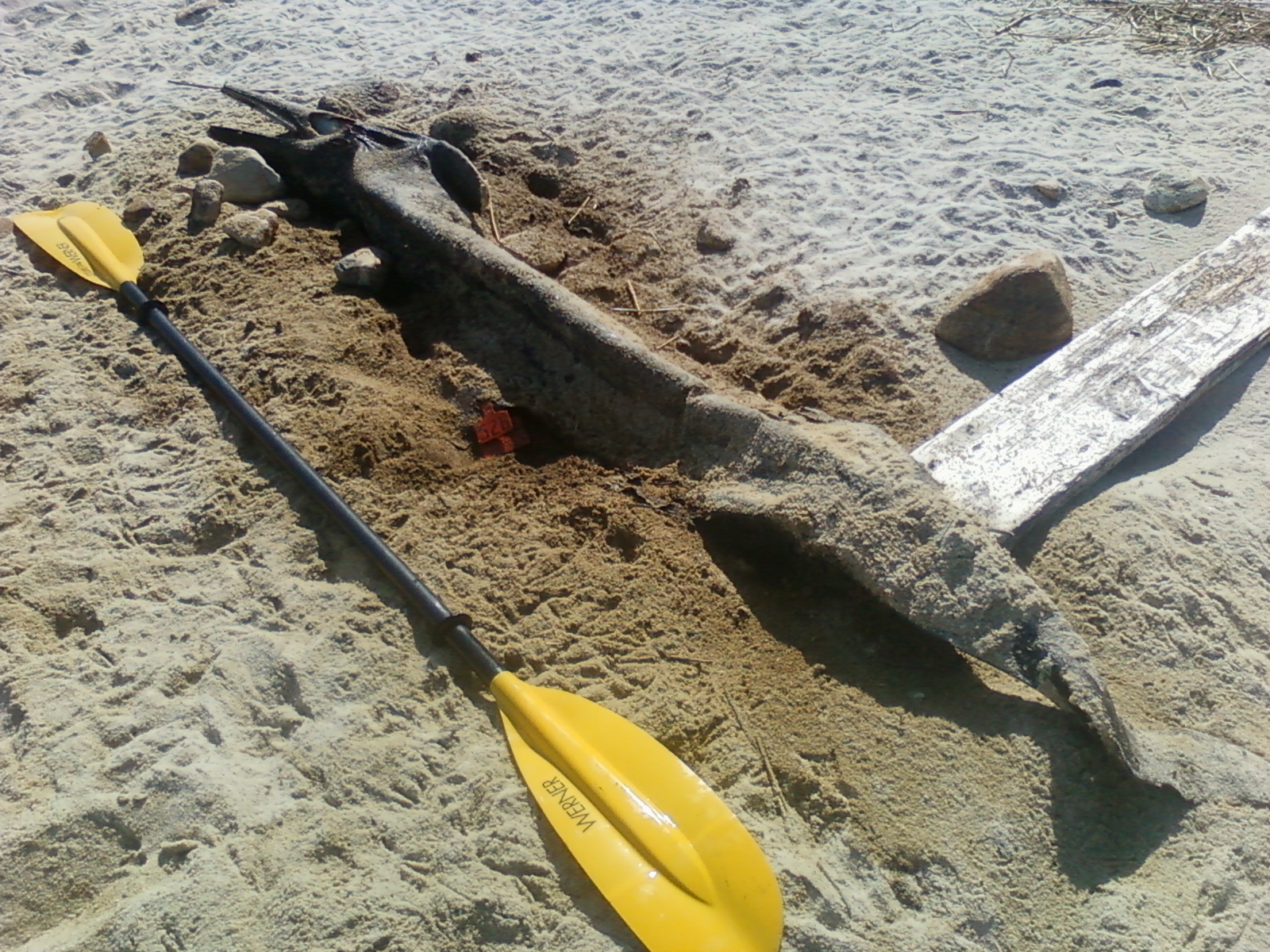
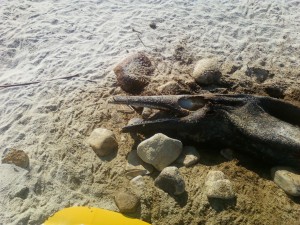
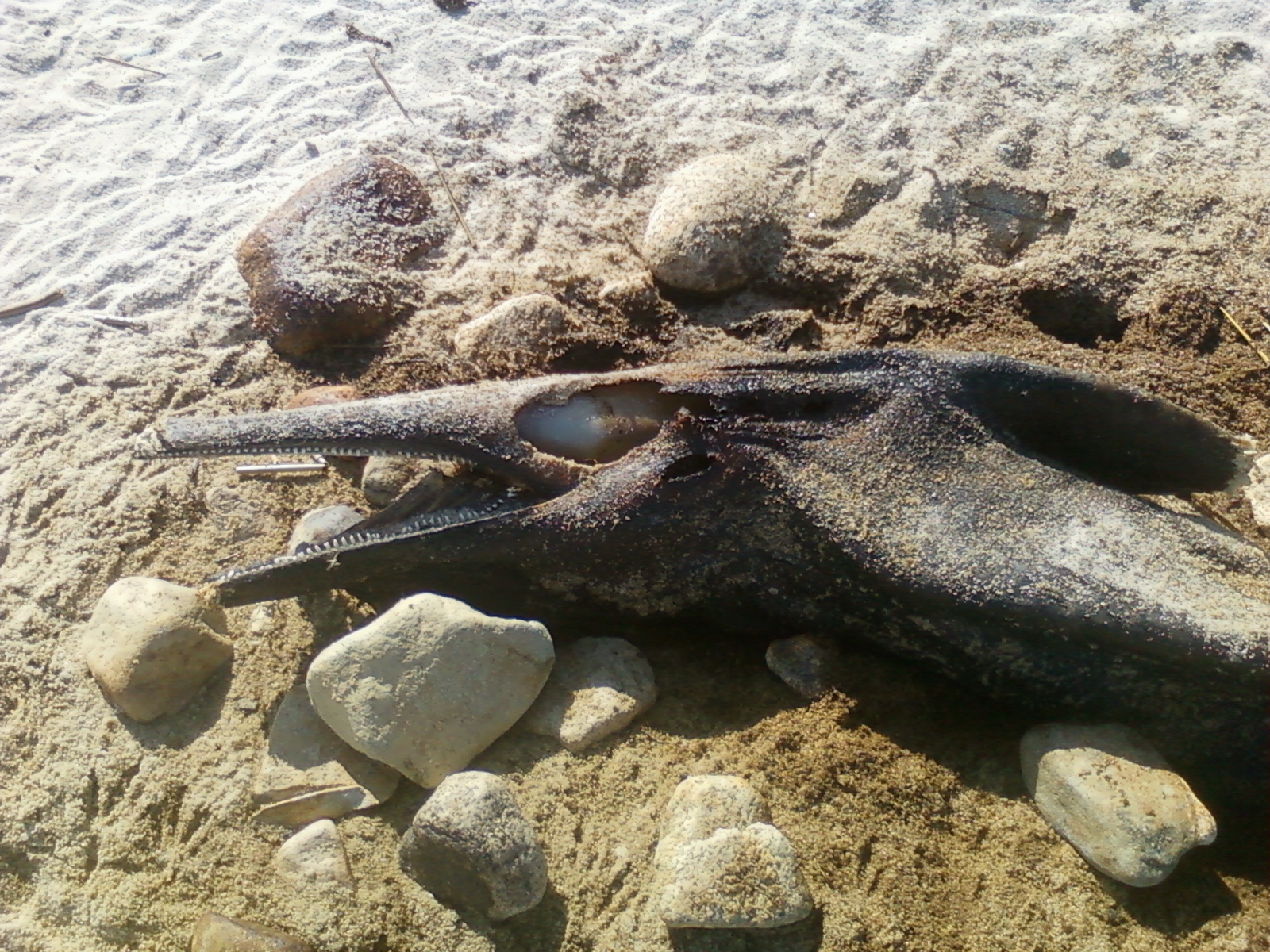
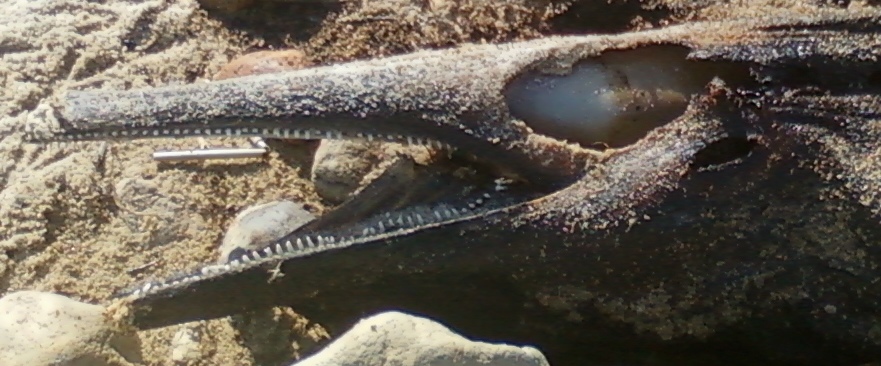
+++++
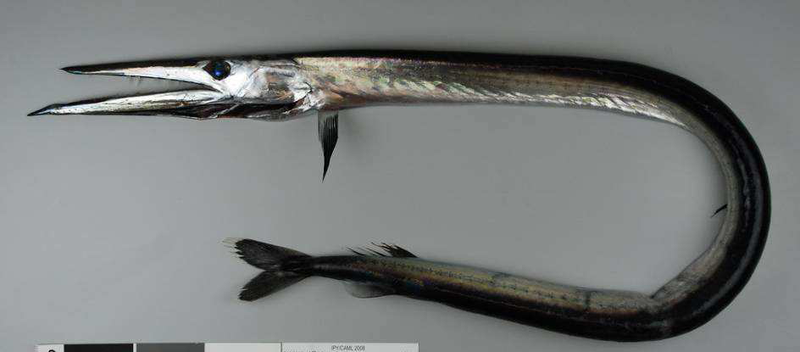

Could it be a relative of the newly Antarctic species of daggertooth discovered in 2008 (Anotopterus vorax)?
Or a dolphin, as many comment makers think (see below)?
About Loren Coleman
Loren Coleman is one of the world’s leading cryptozoologists, some say “the” leading living cryptozoologist. Certainly, he is acknowledged as the current living American researcher and writer who has most popularized cryptozoology in the late 20th and early 21st centuries.
Starting his fieldwork and investigations in 1960, after traveling and trekking extensively in pursuit of cryptozoological mysteries, Coleman began writing to share his experiences in 1969. An honorary member of Ivan T. Sanderson’s Society for the Investigation of the Unexplained in the 1970s, Coleman has been bestowed with similar honorary memberships of the North Idaho College Cryptozoology Club in 1983, and in subsequent years, that of the British Columbia Scientific Cryptozoology Club, CryptoSafari International, and other international organizations. He was also a Life Member and Benefactor of the International Society of Cryptozoology (now-defunct).
Loren Coleman’s daily blog, as a member of the Cryptomundo Team, served as an ongoing avenue of communication for the ever-growing body of cryptozoo news from 2005 through 2013. He returned as an infrequent contributor beginning Halloween week of 2015.
Coleman is the founder in 2003, and current director of the International Cryptozoology Museum in Portland, Maine.










I dont know, but this seems to me like dolphin corpse. The skull is similar.
Looks fake to me
Any marine experts here? I sure am not one. I do wonder what a sturgeon fossil looks like though.
while i dont know what it is, it looks like someone just threw a bunch of random animal parts together to me… i think its fake.
The head and teeth look cetacean, and I don’t see any nostrils, so I would have liked to see more photos to check if it had a blowhole on top.
The body seems serpentine, so my first reaction was ‘Zeuglodon!’
*IF* this is indeed a real carcass and not a hoax.
Looks like a fake, but also resembles a Conger Eel (body and size) as well as a Lizard Fish (head). There have been more and more Lizard Fish being found in Buzzard’s Bay and they look very similar to that with a reptilian head. Have never heard of any reaching that size, which makes me either fake or Conger Eel.
Does look cetacean but what’s up with the Pteranodon head ?
Of course any of us Cryptomundians would have snagged it.
Would be great if regular beachcombers, when they find something
like this, could wrap it in a towel, drag it away from the ocean, and give us
a chance to see it. While jet skiing thru the Everglades my brother and I found a dead Manatee the size of a VW washed up on an obscure island. We reported it.
When the Game Wardens went to check it out, it had already been washed back into the ocean by the high tide, never to be seen again. Unless someone has grabbed this by now, it’s long gone.
To me it looks like an Anotopterus spec.
The body is far too straight like a plank for a dead creature.
If it is real the photographer would have dragged it home with him so to me this screams fake! ( or i`m the pope!! )
P.S. The dentition is also incorrect for a ( i presume ) supposed predatory fish eating sea creature, not to mention why would a sea creature need a Pterosaur like head piece ?
Also the creature is obviously made of two different body parts.
At first glance the tail and body reminded me of a Frilled Shark, but once I saw the head close up it kinda fell apart for me. The teeth are so regular that it just doesn’t look real to me.
http://www.skullcleaning.com/userfiles/image/services_photos_31_large.jpg
It’s an eel?
It’s an eel? Someone could have put a dolphin skeleton head on it?
Looks like an eel and they put another skeletal head on it
Probably a spinner dolphin or something similar – note that in the photos, the corpse is upside down!
wow!
i would like a better look at the body- hard to see if there are any limbs on there.
what I am seeing is this:
1. the tail appears to be oriented vertically (mammalian flukes and flippers are horizontal)… but maybe it is twisted somewhat… it is hard to determine.
2. the teeth look numerous, fine and unspecialized (i.e. molars, carnassials, incisors etc.)
from this, i think that we are looking at something piscine (osteichthyes or chondrichthyes), not mammalian.
(I am not going to consider herpetic yet- i feel that one should explore the most probable and plausible solutions first, and then revisit the unlikely if and when that fails).
I would guess a swordfish.
one thing i think we can probably agree on right now though- it must stink! 🙂
thanks Loren… exciting, and a good exercize in solving the riddles of decomposition.
Skull doesn’t look fishlike. I was thinking cetacean, but look how far forward the eye sockets are, past the beginning of the mouth. That doesn’t fit any dolphin skull I can find, nor T. shepherdi. The rest of the carcass does have have more of an eel look… I’m thinking hoax.
The skull is definitely cetacean, and if you look carefully you can see the tail fin is mammalian. Further Cape Cod is a common sighting ground for dolphins and small whales, I think it is safe to say that is a known mammal, and as it appears to have a light colored flesh I would venture to say it is either a Harbor Porpoise or an Atlantic White-Sided Dolphin.
If it is a hoax, the hoaxer was smart enough to place scavenger tracks all around the carcas, or made it from something organic.
Reminds me of an oversized sea horse.
If it isn’t a hoax, it is likely an undiscovered animal.
Its head is very Pterodactyl-like – note the horn that seems to be a rear extension of the upper beak.
Can’t make any comments about the eyes because they seem to have been eaten by the scavengers.
The orientation of the tail is horizontal suggesting a mammal or perhaps modified reptile tail.
I hope remnants of this creature are found!!
It’s an Obvious Fake, Look at the Position of the Small Rocks around the Head as if were arranged by accident on purpose, The carcase of whatever it is, Is either some real decaying animal or a good paper mache or plaster model, I’m not buying it.
I really don´t think this is a hoax, many poeple are way to eager to claim everything they don´t know or don´t understand is a hoax. The animal in question is obviously photographed from the wrong direction, what seems to bee an eye is in realitiy a deffect of the skin where a part of the mandible is visible. (Could you post a modified photo which shows it upside down Loren?). You can also see the hole in the skin where the eye originally was. This carcass was quite obviously lying for some time in the sun, it it has shrunken a lot. But there is still a lot we can see. So what do we see?
At first we know how big it is, and as there is luckily something for comparison, we can be comparably sure the stated length of around 2 m is true.
If we look at the head, we see long jaws with numerous tiny and quite homodont teeth (so obviously nothing Zeuglodon/Basilosaurus-alike, they had very large heterodont teeth, and there is absolutely no reason to think this is some kind of archaeocete). The thing what seems to be the throat is actually the melon area of the head. There aren´t any nostrils or gill openings visibile, so that´s another indication against a fish as identification.
If we look at the body, we see two pectoral fins without any visible spines (so another indication for a mammal), and except the tail fin – which is horizontal – there aren´t any other fins. The body is quite slim, but we have to keep in mind that this carcass was probably scavenged, it dried on land, and there is a strange phenomen which can cause whale carcasses loose their intestines, what results in quite lean carcasses. Possibly it´s a result of internal decomposition which bloats the abdominal cavity until it bursts, or there is some combination with scavenging, but in any way, there are other cases known in which whale carcasses have become “thin” in a similar way.
So after a critical examination of the photos, there is no doubt for me this was nothing but a dead dolphin. I have to check my archives of whale skulls before I dare to say what species it could be however, but as there are good photos of the teeth, it should be possible to determine the species.
Just for comparison, here is a photo of a Pacific humpback dolphin carcass in a similar condition.
I don´t say this is a humpback dolphin, I only wanted to show that decomposition in the sea and possibly also scavenging can make a dead dolphin loosing its intestines, so it looks very slim.
BTW thylo, swordfish and their relatives have no teeth…
A spinner dolphin (Stenella longirostris) could really be the true idendity, the overall size fits, the shape of the jaws, those numerous teeth as well as the location:
http://what-when-how.com/marine-mammals/spinner-dolphin-marine-mammals/
However it could be another Stenella species as well.
SWORDFISH
The carcass is surely no fish at all. It looks similar at the first look, but this is only a result of the position of the carcass, the thin body and the missing skin over the mandible. IF it would be a fish, you would see a hole where the eye seems to be, but actually there is nothing but bare bone. The pectoral fins would be also in a completely wrong position. Here is also another very good photo which shows how numerous and fish-like dolphin teeth can look:
http://en.wikipedia.org/wiki/File:Delphinus_delphis_teeth.jpg
This carcass is another good example how a dead animal can look like something very different, but still that´s nothing but a dead dolphin.
If you look at a dolphin skull with long jaws, like this Stenella attenuate, and turn it for 180°, it perfectly fits the animal in question. You can even see the big area at the base of the mandible which looks like an eye at the carcass:
http://www.skullsunlimited.com/userfiles/image/variants_large_3910.jpg
dolphin
Sordes is 100% correct on this and I came to the same conclusion without even reading his post.
When I first saw it my immediate reaction was that the orientation of the head was photographed the correct. I wanted to think it was a dolphin but…where is the cranium? So I looked at it upside down and
I was left with little doubt that this animal is a dolphin. The “pteranodon crest” is simply a flipper and that also becomes obvious when the picture is flipped. The eye socket is not the giant hole with the exposed bone (lower jaw) but rather the smaller hole below and to the right of the large one. The cranium of the head is also obvious when the picture is flipped. The tail is also horizontal like in marine mammals, not vertical like it is with fishes.
This is what happens when people unfamiliar with the natural world come across something seemingly out of the ordinary but actually normal and mundane. This is just like the Montauk monster, globsters, the Zuiyo-maru carcass, chupacabras and many other cryptids. These cases of mistaken identity aren’t the faults of any particular person. How would the average person know what a dead dolphin or raccoon looked like? But perhaps rather than sensationalize these things we should just look at it from a logical point of view. Try to understand what we’re actually dealing with rather than automatically turn to the supernatural or fantastical and get the media in a frenzy over nothing.
It looks like a first glance to be an eel with a Pterodactyl/Pterosaur head. That might ring the alarm bells of some, making the conclusion that this could be a hoax, but then again the ocean is a vast realm, and something with a head similar to a Pterodactyl but totally unrelated to such animals is not unlikely (Duck Billed Platypus has a bill like a ducks, a body and tail like a beaver, but is not related to either).
If this body is not found soon, its history. We have to stress to people the great importance of physical type specimens.
Hoax? I think its possible, but I won’t make a conclusion for hoax or reality until we know more about the circumstances surrounding this incident.
Yep, desiccated carcass of a dolphin.
The daggertooth photo is misleading as it’s trying to visualize the remains straight from the carcass photo. As others have mentioned, the original photo is looking at the carcass from the top down, with the large empty “socket” merely a hollow to reduce weight in the lower jaw. The teeth and basic layout are the key indicators. Whales, porpoises and dolphins are the only sea-going critters with pegged teeth. (Not discounting ancient extinct species that were much, much, much larger.)
Thanks to the new Animal Planet mockumentary….
IT’S A MERMAID!!
But seriously…. Wow. I dunno. I like the theory it’s been a dolphin, and the photo needs to be flipped. I also like the undiscovered theory.
If it’s a hoax, that sucks. Hope the effort won’t be worth the day of attention.
I’m pretty sure the mystery has been solved. Dolphin
In addition to the dolphin identification I think it’s worth to mention that since new year Cape Cod (for example Brewster or Wellfleet) has seen massive strandings of dolphins.
If it’s a dolphin, the overall skinniness even with dehydration looks odd, as does the lack of the dorsal fin. (Can’t tell if that’s a reddish rock or possible remains of the dorsal “under” the body as photographed?) Yet I will concede the S. attenuata skull looks like a pretty good fit, so this one goes from “probable hoax to “probable cetacean” in my mind.
As I said before, there is a strange phenomenon of decomposition which can result into “hollow” whale carcasses, which have lost all their intestines and sometimes even their spine. In the case of the Moore Beach carcass – which was of course nothing but a dead Baird´s Beaked whale – a similar condition was present. Such carcasses can look extremely slim. This sperm whale carcass is a similar case, its abdominal cavity seems to be nearly completely hollow:
If you take a close look at the first photo of the mystery carcass, you can even see at the middle of the back next to the red “thing” a structure which seems to be a dried and shrunken dorsal fin, which is partly covered with sand. As usual, it would be much easier to identify the carcass, if there would be better photos from all directions and with more anatomical details.
Here is another photo of a dolphin carcass in a very similar condition:
There is even an “eye” at nearly the same location, which is nothing but a hole in the skin.
See the red marker with the number 526 in the first picture? This means that someone had recorded this stranded animal. I don’t know who is responsible at Cape Cod for marine strandings but I think this could be the people from the International Fund for Animal Welfare (IFAW) as I’ve seen pictures of them with those markers at CC. If you want to know the species – follow this number and ask them.
In the meantime – watch a video of number 515 (beginning at 0:53) at Wallfleet.
My thanks to maslo63, markos and especially to sordes for their rigorous zoology homework.
Certainly appears to be a dolphin, exact species yet to be determined.
The stranded dolphins at Cape Cod were “common dolphins”. This includes two or possibly even three species, but it was most probably a long-beaked common dolphin (Delphinus capensis).
Maybe the rest of it is missing and it’s just the neck and head of one of these?
Given the geographical location it actually seems to be much more probable it was a short-beaked common dolphin (Delphinus delphis) and not a long-beaked common dolphin.
It appears to be a very decomposed needlefish. It’s rare to find them in the Western North Atlantic, but not unheard of.
number6, if you would have taken the time for a close look at the photos and would have read the comments, you would know this is obviously and without any doubt a dolphin carcass.
That fish look very much like one that I caught when I was very young while fishing with my Grand Father, off the coast of southern California. My Grand Father had no idea what is was and took it to Marine Land Aquarium. They called him and told him that it was a Needle Fish, rather rare. It was the only one that him or myself ever saw. We fished together for over thirty years.
Yeah I’m going with Needle Fish.
teradactyle!! stupid spell check.
The carcass lacks obvious features of a fish like gill covers or rays of the fins but shows many mammalian features. As I pointed out before, the apparent eye is only a hole in the skin. If it would be a fish, you would see an eye socket, but there is only plane bone.
Furthermore this carcass was photographed where a mass stranding of common dolphins occured not that long ago, it was marked with a number like the other dolphin carcasses, and there is absolutely no more reason to think this was anything else than a dolphin carcass.
I admit there is a vague similarity to a needlefish, but only because there seems to be an overall resemblance, this doesn´t mean it is a needlefish. If you try to identify an unusual carcass, you have to look at anatomical features, especially those which are not affected by decay. Soft tissue of carcasses can decay in quite strange ways and can change the appearance of an animal completely.
If you look at the skull of a needlefish you see some superficial similarities, but also clear anatomical differences:
The eye opening in the skull of needlefish is very big, and completely different from the plane bone you see at the “eye” of the carcass. You can also see the jaws of needlefish are more fragile than those of the carcass. Furthermore the whole carcass would be extremely large for a needlefish and even for a houndfish. The teeth of needlefish look also somewhat different, there are bigger interdental distances. There are also no pectoral fins visible, and a needlefish would not explain the structure behind the head (actually the pectoral fin of the dolphin). And the red mark is also exactly at the position where the dorsal fin would be in a dolphin, and actually the dorsal fin is still partially visible.